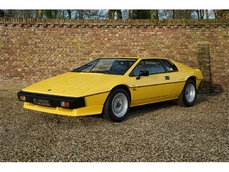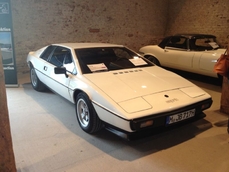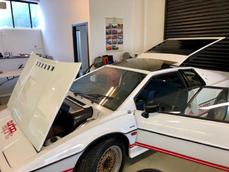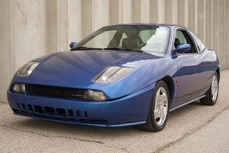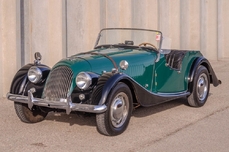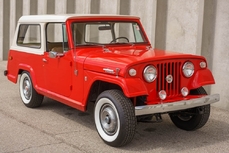Lotus Esprit SE 1991
General description :
1991 Lotus Ésprit SE
This is the third of 4 1991 Éspirit SEs exported to the US in this exterior/interior combination; one of 1,608 Ésprit SE models made between 1987 and 1993
2.2L turbocharged four-cylinder engine with Lotus/Delco multi-point fuel injection and air-water-air intercooler ‘Chargecooler’ (code 910S)
Renault UN-1 five-speed manual transmission
Monaco White exterior (code A21) with New Raven leather interior with grey carpet
Air-conditioning, power windows and power mirrors
Driver’s side airbag and four-wheel disc brakes with anti-lock
Removable roof panel, rear wing, fog lights and VDO gauges
Full timing belt service and tensioners performed on 12/2015
Widely known for its original wedge shape, penned by Giorgetto Guigiaro, and a famous turn as James Bond’s supercar and supersub in the movie, “The Spy who Loved Me,” designer Peter Stevens restyled Guigiaro’s original Lotus Ésprit in 1987, rounding off some of the original’s angles to carry it into the next decade. This particular Lotus has spent time in New Jersey, Florida and New Hampshire.
This example is one of 1,608 Ésprits SE models made between 1987 and 1993 and the third of four ’91 SEs exported to North America in this exterior/interior combination and was made in August 1990. It was imported into the country via Lotus Cars USA, Inc., and the original dealer was Summit, Inc. in Summit, New Jersey. It went into service on September 5, 1990.
The car was acquired by the previous owner in 2019, reportedly after an extended period of storage and services in preparation for the sale are reportedly to have included fluid changes, refurbishment of the headlight motors and window motor wiring and an air conditioning service but currently the AC blows warm. A full timing belt service and tensioners were performed on 12/2015 at Precision Imports in New Hampshire.
Dressed in Monaco White (code A21) with body-colored sideview mirrors, the car’s paint and trim are in overall very good order with some imperfections such as a small crack on the passenger rear fender. The bodywork is straight. There’s a removable roof panel in place of a sunroof or T-tops. The car’s frunk is clean and contains a spare tire and wheel, fuses, battery, plumbing for air-con and brakes, washer reservoir, etc. A cantilevered monowiper cleans the windshield. Out back, the engine bay is very tidy and there is a small, carpeted cargo well that might serve well to store luggage in for a weekend getaway or for one set of golf clubs. The cargo aera is closest to the driver when standing at the open hatch, with the engine forward of the well and the cabin in the background.
Body panels were done in Lotus’ vacuum assisted resin injection (VARI), patented by the company and, with Kevlar reinforcement added to the roof and sides for rollover protection, the car’s torsional rigidity rose 22 percent.
This Lotus rolls on Falken ZE912 radials, size 205/50R15 in front and 245/50R16 in rear. Each tire is mounted to a body-colored Lotus/O.Z. Racing wheels. The wheels are in excellent order while the tires are in very good condition.
Just behind the seats is a 2.2L turbocharged four-cylinder engine with a single Garrett AiResearch T3 turbocharger. In mid-1989, the Bosch fuel injection system was replaced by Delco GMP4 electronic fuel injection that included a crank-fired wasted spark ignition that eliminated the need for a distributor. In 1990, the engine was upgraded with an air-water-air intercooler called a Chargecooler to become the type 910S. Maximum boost was raised to 12.4 psi. Recent services reportedly include a timing belt replacement done under previous ownership and an oil change performed prior to the sale.
This motor is linked to a Renault five-speed manual transmission (code UN-1). Driver convenience features include air-conditioning, power windows and power sideview mirrors.
Inside, the cockpit is upholstered in New Raven leather with grey carpet. The instrument panel, door panels and center console all match. Wear is present on the seat bolsters, center console and the dash surfaces. A General Motors, four-spoke steering wheel (GM owned a controlling interest in Lotus from 1986 to 1993) with airbag frames a full set of VDO instruments, digital clock and switches housed in a dash of burled wood but the anti-lock dash light is iliminated and the fog lights are inoperable. An aftermarket AM/FM stereo with CD player completes the interior.
In 1987, the Ésprit was restyled by British designer Peter Stevens. Stevens, who would later go on to design the McLaren F1, produced a less angular, more rounded Ésprit. Giugiaro is said to have liked the new shape, claiming it was perhaps too close to his original design. The exterior changes were accompanied by a redesign of the interior that gave more space to the occupants. The revised Ésprit was not given a new “Series” number but is often called by its project code of X180.
Panels for the body were produced using a new process called VARI (Vacuum Assisted Resin Injection). This method, which was patented by Lotus, offered advantages over the previous hand lay-up process. Kevlar reinforcement was added to the roof and sides for roll-over protection. This contributed to a 22 percent increase in the Esprit's torsional rigidity.
The X180 cars inherited most of their mechanical components from the earlier HC Esprit and Turbo Esprit, although the name for the forced induction model was now Esprit Turbo. 1988 model year North American Esprit Turbo models kept the Citroën transaxle and Bosch fuel injection system used in the previous model year. Other X180 models received a new Renault UN-1 transaxle, which necessitated a move to outboard rear brakes.
In 1989, the K-Jetronic system was replaced with a Lotus/Delco multi-point fuel injection (MPFI) system. The engine also received an air-water-air intercooler called a Chargecooler by Lotus. This revised engine was known as the Type 910S. The 910S engine went into the new Special Equipment (SE) model, which also received changes to the body, with side skirts parallel to the body, five air ducts in the front air dam, wing mirrors from the Citroën CX and the addition of a rear wing.
Competition to this Lotus in 1991 included Acura’s NSX, BMW’s 850i, Chevrolet’s Corvette, Nissan’s 300ZX Twin Turbo and Porsche’s 911 Carrera 4 and 928 GT.
If you believe in Lotus founder Colin Chapman’s idea of keeping things simple, this Ésprit should appeal to you as it stands apart from its competition with its light weight, short list of amenities and brilliant shape. Stop by MotoeXotica Classic Cars today and check it over.
VIN: SCCFC20B7MHF60072EIN: LP 910 9008 27428 C
TIN: 002309
This car is currently located at our facility in St. Louis, Missouri. Current mileage on the odometer shows 43,233 miles. It is sold as is, where is, on a clean and clear, mileage exempt Missouri title. GET OUT AND DRIVE!!!
https://www.motoexotica.com/inventory/inventory/15277/1991/Lotus/Esprit/SCCFC20B7MHF60072.html
1991 Lotus Esprit SE is listed sold on ClassicDigest in Fenton (St. Louis) by for $36900.
Car Facts
Car type : Car Make : Lotus Model : Esprit Model Version : SE Engine size : 0.0 Model Year : 1991 Location : Fenton (St. Louis)
Sold
Seller Information
Sold
People who viewed this Lotus Esprit also viewed similar Lotus listed at ClassicDigest
Other cars listed for sale by this dealer
About Lotus Esprit
The Lotus Esprit is a British sports car that was produced by Lotus Cars from 1976 to 2004. It was designed by Giorgetto Giugiaro and is widely regarded as one of the most iconic sports cars of the 20th century.The Esprit was powered by a range of engines over the years, including a 2.0-liter inline-four, a 2.2-liter inline-four, and a 3.5-liter V8. It also featured advanced suspension and braking systems, with four-wheel independent suspension and disc brakes on all four wheels.
The Lotus Esprit was known for its exceptional handling and performance, with a top speed of up to 175 mph and acceleration from 0 to 60 mph in as little as 4.7 seconds. Its aerodynamic fiberglass body and mid-engine layout made it a popular choice among sports car enthusiasts of the time.
The Esprit was also featured in a number of popular films and TV shows, including the James Bond film "The Spy Who Loved Me," where it famously transforms into a submarine. Its unique design and exceptional performance make it a sought-after classic car today



